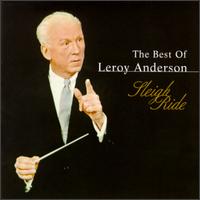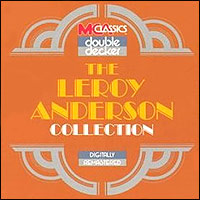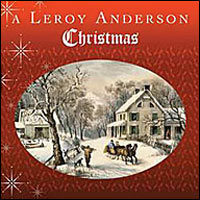|
Music Reviews
Alternative
Blues
Books
Christmas
Classic Rock
Country
Jazz
Lounge
Oldies
Power Pop
Punk & New Wave
Reggae
Rhythm & Blues
Seventies
Texas
Special Features
Randy's Rodeo
Sex Pistols
Motown
Halloween
Valentine's Day
Information
About Me
Feedback
Links
User's Guide
Support Me
Amazon
iTunes
Sheet Music Plus
|
Sock it to me, Santa! Visit my other website, www.hipchristmas.com Visit my other website, www.hipchristmas.com
 In
my far-flung musical travels, the effervescent pop of Leroy
Anderson is about as far as I stray into the terra incognita of bona
fide easy listening. Long ago, my parents took me to see Arthur Fiedler
and the Boston Pops performing such Anderson classics as "The Syncopated
Clock." Anderson got his start, actually, writing and arranging for the
Pops in the 1930's, and it was there that he developed his trademark sound.
Anderson's style depended in no small way on the use sound effects and showmanship,
but patrons left Symphony Hall humming the melodies - not the gimmicks. In
my far-flung musical travels, the effervescent pop of Leroy
Anderson is about as far as I stray into the terra incognita of bona
fide easy listening. Long ago, my parents took me to see Arthur Fiedler
and the Boston Pops performing such Anderson classics as "The Syncopated
Clock." Anderson got his start, actually, writing and arranging for the
Pops in the 1930's, and it was there that he developed his trademark sound.
Anderson's style depended in no small way on the use sound effects and showmanship,
but patrons left Symphony Hall humming the melodies - not the gimmicks.
There is, to be sure, nothing very funky about Anderson's tunes. That said,
let us praise this mainstream maestro for his lively, inventive contributions
to modern culture. Anderson was a triple threat - composer, arranger, conductor
- who
weighs heavily in the history of pop music. Trained at elite east coast institutions
like Harvard, this son of Swedish immigrants joined the Boston Pops at Fiedler's
behest and by 1938 was churning out playfully swinging charts like "Jazz
Pizzicato" and "Jazz Legato."
Following World War II - during which he served with the Scandinavian intelligence
service(!) - Anderson unveiled "The Syncopated Clock," an immortal
tune employing the techniques that became his signature. Through the clever
use of traditional instruments and the judicious use of sound effects, Anderson's
songs wordlessly evoked an impressionistic, amusing, alternate reality - not
unlike Prokofiev's "Peter & The Wolf" or Grofé's "Grand
Canyon Suite."
 In "The
Typewriter," for instance, Leroy Anderson called upon his percussionist
to play an actual typewriter - carriage returns and all. But in "Sleigh
Ride" his players imitated spunky sled horses using nothing more than trumpets
and wood blocks. While "Syncopated
Clock," predictably, portrays
a timepiece with a singular affinity for rhythm, other compositions vividly evoke
animals ("The Waltzing Cat"), seasons ("The First Day of Spring"),
household objects ("Sandpaper Ballet"), or merely glorious nonsense
("Plink Plank Plunk!" and "Fiddle Faddle"). In "The
Typewriter," for instance, Leroy Anderson called upon his percussionist
to play an actual typewriter - carriage returns and all. But in "Sleigh
Ride" his players imitated spunky sled horses using nothing more than trumpets
and wood blocks. While "Syncopated
Clock," predictably, portrays
a timepiece with a singular affinity for rhythm, other compositions vividly evoke
animals ("The Waltzing Cat"), seasons ("The First Day of Spring"),
household objects ("Sandpaper Ballet"), or merely glorious nonsense
("Plink Plank Plunk!" and "Fiddle Faddle").
Anderson continued working with the Boston Pops till shortly before his death
in 1975, but he made his biggest splash upon founding his own orchestra for
Decca Records in 1950. During the next few years, Anderson mainly recapitulated
his greatest hits in a series of singles - remember, these were the days before
the standard 12-inch LP. But, during 1951, the maestro scored a #1 hit (and million-seller)
with "Blue Tango," an exotic piece that capitalized on the current
American craze for all things Latin. More recordings - and new compositions -
would follow, but by the early 60's rock 'n' roll had driven Anderson's brand
of musical whimsy all but off the charts. As one writer notes, however, everyone
knows Leroy Anderson's songs - even though they may not know the title, let alone
the composer!
 The
Decca recordings (1950-1962) are documented on the smartly-annotated, crisply-mastered Sleigh
Ride: The Best Of Leroy Anderson (1997). In the alternative, purchase MCA's
inexpensive 47-song, 2-CD set, The
Leroy Anderson Collection (1988) - more comprehensive, but cheaply packaged.
Of course, as America's most popular composer, many recordings of Anderson's work
now dot the commercial landscape. More notable albums include tributes by conductors Leonard
Slatkin, Frederick
Fennell, and Erich
Kunzel. The
Decca recordings (1950-1962) are documented on the smartly-annotated, crisply-mastered Sleigh
Ride: The Best Of Leroy Anderson (1997). In the alternative, purchase MCA's
inexpensive 47-song, 2-CD set, The
Leroy Anderson Collection (1988) - more comprehensive, but cheaply packaged.
Of course, as America's most popular composer, many recordings of Anderson's work
now dot the commercial landscape. More notable albums include tributes by conductors Leonard
Slatkin, Frederick
Fennell, and Erich
Kunzel.
Finally, as the title of Sleigh
Ride: The Best Of Leroy Anderson implies, the composer is best remembered
for his effervescent holiday tune - which was originally written as an instrumental
and which, even in the Mitchell Parish-penned lyrics, never actually mentions
Christmas. Those seeking more (or, rather, less) of the same, however, should
track down A
Leroy Anderson Christmas (2004), which includes the Boston Pops' rendition
of "Sleigh Ride" and Anderson's own performance of "A Christmas
Festival," his epic arrangement of seasonal favorites. [top of page]
 Selected Leroy
Anderson Albums Selected Leroy
Anderson Albums
[top of page]
 Essential Leroy
Anderson Songs Essential Leroy
Anderson Songs
- Blue Tango (1951)
-
Bugler's Holiday (1954)
-
Clarinet Candy (1962)
-
Fiddle Faddle (1947)
-
Jazz Legato (1938)
-
Jazz Pizzicato (1938)
-
Plink Plank Plunk! (1951)
-
Sandpaper Ballet (1954)
-
Sleigh Ride (1948)
-
Song of the Bells (1951)
-
Syncopated Clock (1945)
-
Trumpeter's Lullaby (1945)
-
Typewriter (1950)
-
Waltzing Cat (1950)
[top of page]
 The Leroy
Anderson Bookshelf The Leroy
Anderson Bookshelf
[top of page]
 Leroy Anderson On The Web Leroy Anderson On The Web
[top of page]
 Feedback Feedback
Your witty comments, impertinent questions, helpful suggestions, and angry denials
are altogether encouraged. Submit feedback via email;
submissions will be edited and posted at my discretion.
|
|